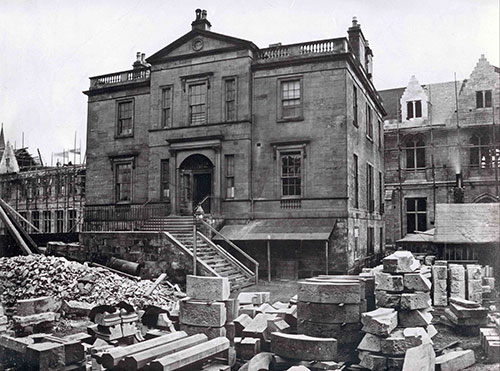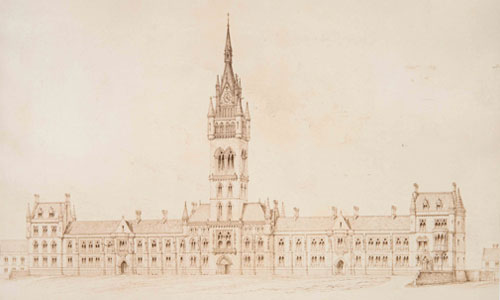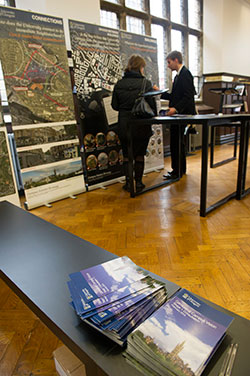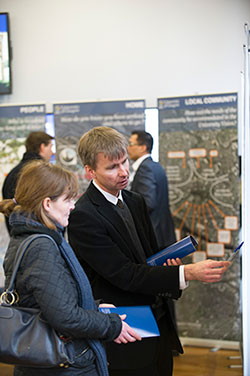Echoes from the past in Campus Vision
Published: 4 July 2013
Does this sound familiar? “The buildings of the College have long ceased to be adequate... to the requirements of modern instruction in literature and science as now taught at the University... ”
By Phil Taylor
Does this sound familiar?
“The buildings of the College have long ceased to be adequate... to the requirements of modern instruction in literature and science as now taught at the University. That this evil has at last become so great as to render it necessary that two, in some instances three, classes should successively receive instruction in the same room, a state of things always objectionable from the impossibility of maintaining the air in a healthy condition in rooms occupied during so many hours by large bodies of students... ”
It is a paragraph from a letter the Principal sent to the Queen, asking for help in funding a move of the University to better accommodation. But in this instance, the Principal was Duncan Macfarlan and the Queen was Victoria. The year was 1853 and the Principal and Professors were developing their own Campus Vision that, by the end of 1870, would lead to the move from the Old College in the High Street to Gilmorehill. Such was the public interest in the project, that 20,000 people turned up to watch the Prince and Princess of Wales lay a foundation stone each in October 1868.

The story of that 19th century project is contained in the recently published book, Building Knowledge, by Nick Haynes and published by Historic Scotland in partnership with the University. It is far from a dry and dusty tome: for instance try reading the account of the celebratory procession organised by the students on a clear night in November 1870 to mark the transfer to Glasgow’s West End. Hundreds marched carrying flaming torches all the way from the High Street, via Sauchiehall Street to Gilmorehill. They had stood to sing For Auld Lang Syne before setting out. On the way they attracted what a contemporary writer called “hooligan elements” and by the time the throng reached what was still a building site at Gilmorehill, a near riot involving students and “roughs” was underway with building materials being liberally used as weapons!
By 1877, the cost of the new University development had reached approximately £428,000, something like £28million by 2013 values. It is not only the relative value of the currency and the availability of labour and materials that have changed, of course. There was little in the way of planning regulations or building control. In the 1870s, the railway companies who had a contributory role in the move to Gilmorehill, could level or undermine large swathes of city centres with near impunity. It was not uncommon for Roman and Mediaeval monuments to be pulverised just to make way for the railway. The land-owning classes could decide what they wished to do with their property with little heed for the local populace or the wider needs of society.
The University of Glasgow, in partnership with architect George Gilbert Scott, was able to plan for the future on an epic scale. The then Glasgow Corporation was fully supportive and was about to spend extraordinary sums building the City Chambers, with its sculptures of Truth, Riches, and Honour and the statues of The Four Seasons on the Chamber's tower. But by one calculation, the industrial powerhouse of Glasgow was in those days producing a thirtieth of the UK’s GDP.

These are very different times for the UK, for Glasgow and for the University. But it is likely that over the coming years, as much energy, excitement, controversy and hard work will be generated by the 21st century Campus Vision as was created in the 1870s.
Ann Allen, the University’s Director of Estates and Buildings says the manner by which the Campus Vision becomes a reality will be very different, but no less far reaching: “I guess we are building for the next hundred years, and I hope that some of what we build in the next few years will still be being used by generations to come.”
Estates and Buildings have been working on a major consultation exercise ever since the acquisition of the Western Infirmary site, and the greater ambitions for the University campus were announced in February of this year.

Ann Allen says: “We wanted to hear people’s view about what they wanted for the long-term future of the Gilmorehill campus. Through the early part of this year we have been running a consultation exercise and we have continued to get feedback from many different quarters. We have run focus groups and other sessions and we have been busy collating the comments and suggestions we have received and that is shaping our thoughts on what the long-term vision should be.
“We have been getting a real sense of what is important to people, things like the amount of green, open space we have here which is unique. The arrangements for pedestrians and cars is important to people and the ability to be able to walk about the campus in safety; but equally we know that many people are dependent on their car in order to be able to get to work. We have begun a conversation with people and it is so important that we hear people’s views now.”
Estates and Buildings, in partnership with Glasgow architects Page and Park, have produced a summary of the key messages that are informing the development framework, a critical part of the estates strategy as this will help to secure the right planning approvals for the site. You can read that document here: http://www.gla.ac.uk/about/campusdevelopment/consultation/ . In brief, the responses from University staff, students, alumni, local businesses and local residents can be summed up in these aspirations:
"I guess we are building for the next hundred years, and I hope that some of what we build in the next few years will still be being used by generations to come." Ann Allen
- Enhance the setting of the campus
- Ensure a sustainable future
- Secure the current and future built heritage
- Embed activities and uses that promote a sense of openness
- Create flexible spaces that respond to identified and changing needs
- Provide clear connectivity within – and to – the University
Ann Allen says this because the Campus Vision will be as far reaching as the ambitious changes and developments of the 1870s. She continues: “We do not take occupation of the Western Infirmary site until 2015, so we won’t be doing any building work there before then. And then it will take perhaps ten or fifteen years to start creating new buildings...perhaps longer, depending on how ambitious we are.
“But what I do know is that we will have some clear plans before we start that process so we’ll know what we are aiming for and we will know why we are building those buildings AND how they will support the future strategy of the University of Glasgow.”

There’s no doubt the time span for the University’s Campus Vision will be generational. But there is still time for you to make your own contribution to that vision. On Friday September 27, staff are being invited to attend the Campus Conversation in the Bute Hall, a morning of conversation with the Principal and senior University leaders. A video being produced for that event will feature the Campus Vision; for the second half of the 0930 – 12.30 event, Director of Estates and Buildings, Ann Allen will be on stage to discuss the planning and consultation process.
Further staff, student and public consultations are also planned for the autumn together with focus groups to study some of the issues raised. It is hoped that by spring next year, the University’s Estates Committee will approve the Estates Strategy, the blueprint for the future, and the Campus Development Framework, the route map that will guide the plan through all the regulatory requirements of the city of Glasgow and the Scottish Government.
First published: 4 July 2013
<< July

